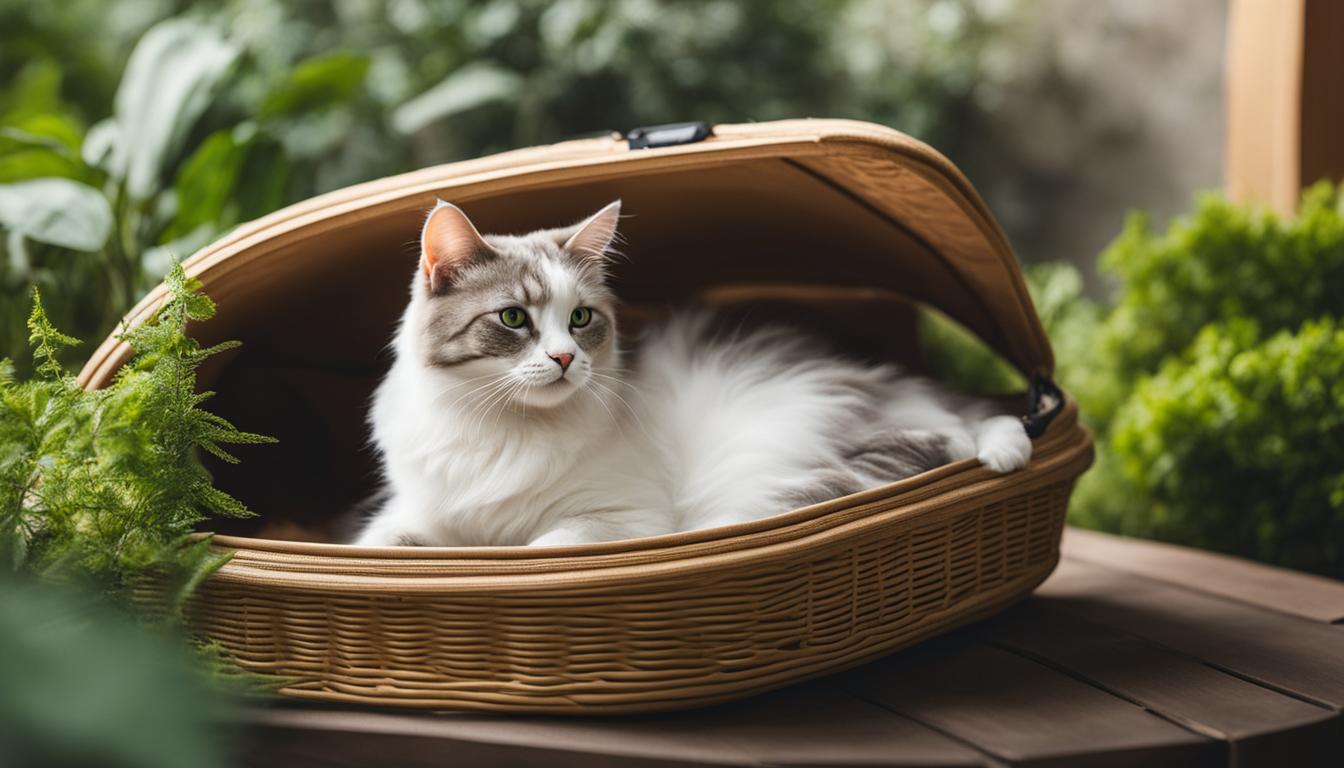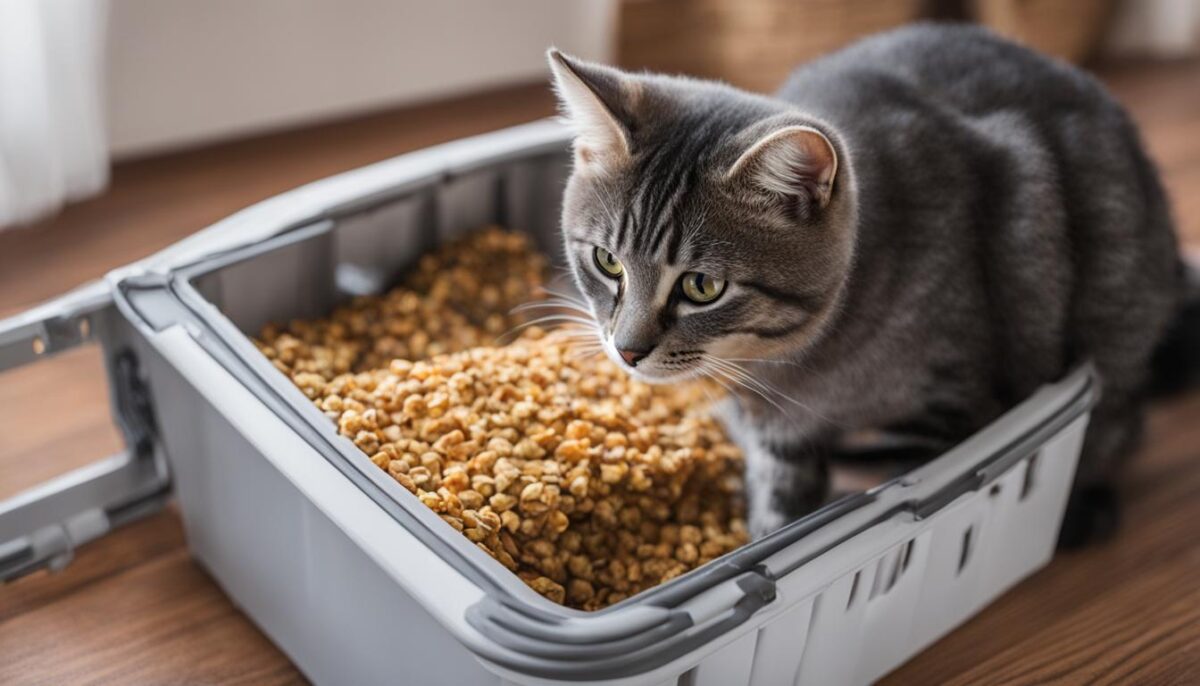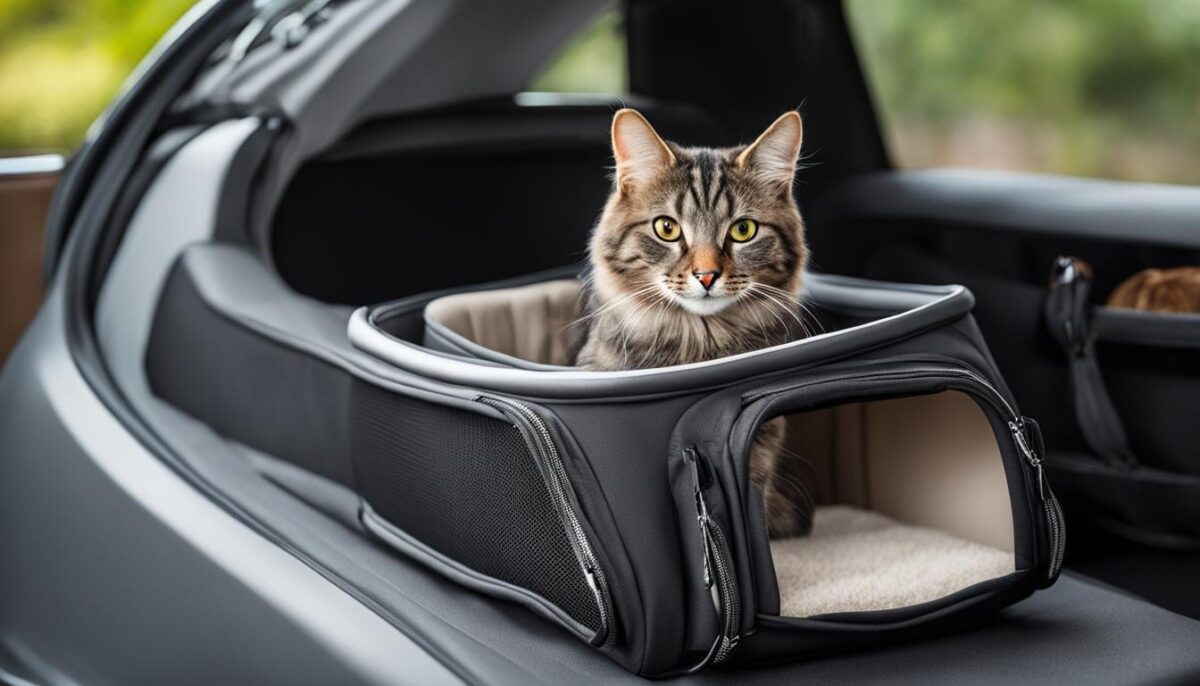Getting your cat to like their carrier can be a big help. It means less worry when it’s time to go places like the vet. With some patience and fun steps, you can teach your cat to feel good about their carrier. Imagine your cat feeling calm and cozy when it’s time to travel. You can use treats and play to make the carrier a happy place for your cat. Try practicing a little bit every day for a stress-free travel experience.
Using simple games and rewards, you can make a carrier a place where your cat likes to be. You’ll find out that with some easy tips, traveling with your kitty can be easy and calm. Taking your time and showing your cat love will help make trips with the carrier a good time for both of you. Let’s learn how to make your cat’s carrier a cozy spot they enjoy!
Key Takeaways
- Use treats to make the carrier a fun place for your cat.
- Keep practice sessions short, so your cat doesn’t get upset.
- Teach your cat that the carrier is safe with games and petting.
- Try practicing a little every day to help your cat remember.
- Keep the carrier out in the open, so your cat gets used to it.
- Be patient, your cat will learn to like their carrier over time.
Understanding Cat Behavior and the Benefits of Carrier Training
Have you ever seen your cat hide when they see something new? Cats can be shy around new stuff because they’re not sure if it’s safe. When you bring a cat carrier into your house, your cat might look at it like it’s a monster! But don’t worry, there’s a way to make that carrier look like a cozy bed instead.
You can start by letting the carrier hang out in the room where your cat loves to play. Leave the door open and pop a yummy treat or a fun toy inside. Cats are curious, and when they sniff something tasty or see a toy they can’t resist, they might just walk into the carrier on their own. And when they do, say good things and give them a little extra treat!
Here’s why getting comfy with a carrier is great for your cat:
- It makes going to the vet easier. No more chasing your cat around the house!
- If you need to leave home quickly, like in an emergency, you can bring your cat along safely.
- It’s good exercise for their brain. Learning new things makes cats happy and smart.
- When your cat learns that the carrier is okay, it helps in reducing cat stress a lot.
Remember, go slow and keep it fun. Your cat is learning that the carrier is part of their home, just like their favorite spot on the couch. With some patience and love, your cat will learn that the carrier isn’t scary at all – it’s just another place for snuggles and naps.
So, teaching your cat to like the carrier is pretty important. It helps keep them calm, makes it easier for you when you need to take them places, and is a big part of keeping them safe. Plus, it’s a nice way for you and your cat to spend quality time together. That’s a lot of benefits of cat carrier training, right?
How to Break Down Training into Simple Steps
Training your kitty to like their carrier can be easy if you go step by step. It’s like when you learn to tie your shoes—one loop, two loops, and then a pull! Let’s make your cat’s carrier their new favorite spot.
Transforming the Carrier into a Comfort Zone
Beginning with only the bottom half of the carrier, make it cozy by adding some of your cat’s favorite blankets and toys. Drop in some yummy treats to make them curious. Remember, just like people, each kitty will take their own time to get comfortable.
Incremental Training Techniques for Positive Associations
Start by giving your cat a treat for just looking at the carrier. Then, each time they go closer or sniff it, give them another treat! It’s like a fun game where getting closer to the carrier means snack time. Slowly, they’ll feel happy to hang out inside for a bit longer.
Reward-Based Training: Treats and Praise
When it’s time to add the top of the carrier, make sure you keep the door off. Let your kitty walk in and out freely, giving them treats and praise. Soon, you can try closing the door for a moment, then opening it again. Don’t forget to give them a treat when you do this. Make it a fun experience, and soon, they’ll see the carrier as a safe and happy place.
Positive reinforcement cat training is all about making your fur friend feel good every step of the way. That’s how you build cat carrier comfort. They’ll start to think, “Hey, this carrier isn’t so bad after all!” In fact, with enough practice and treats, they might just nap in there even when you’re not going anywhere!
Preparing for the Big Day: Travel Tips and Tricks
Before you take your furry friend on their next adventure, you’ll want to make sure they have a comfortable cat carrier. This is a special bag or box with holes so they can breathe easily. It should be snug, yet have enough room for your cat to turn around and lie down. A trip with your cat is way more fun when they are calm and cozy.
Selecting the Right Carrier for Comfort and Safety
There are many kinds of carriers, but the best ones make your cat feel safe. They shouldn’t wobble or tip over in the car. Also, it’s important to let your cat see you, so they know you’re near.
Practicing with Short, Enjoyable Trips Before the Main Journey
You can help your cat get used to their carrier by taking them on fun, little trips. Start with a short drive around the block, then go a bit further each time. This is called short trip acclimation. It’s like practicing for the big game, only it’s a practice for a car ride!
How to Handle Anxiety and Motion Sickness
Sometimes, cats get scared or feel sick in the car. If that happens, there are special sprays and natural remedies you can use. These cat travel anxiety solutions just might make them feel better. If they still don’t feel well, your vet can help you find other ways to make travel easy for your cat.
Remember, the key to a smooth trip with your cat is to make sure they are used to their carrier. Bring along their favorite toy or blanket, too. These things smell like home and can help your cat relax.
Now, let’s look at a table of tips to help you pick the best carrier:
| Tip | Description |
|---|---|
| Size | Big enough for your cat to stand, turn, and snooze. |
| Ventilation | Lots of air holes so your cat can breathe fresh air. |
| See-through Door | A little window so your cat can see you. |
| Sturdy Bottom | A strong base so it won’t tip over in the car. |
With your cat cozy in their carrier, you’re all ready to go. Happy travels!
Keeping the Training Fresh: Practice Makes Perfect
When you’ve worked hard on cat carrier training maintenance, don’t let that work go to waste! You want to make sure keeping your cat comfortable with the carrier is a part of your daily routine. By leaving the carrier out where your cat can explore it anytime, they’ll start to think of it just like their favorite nap spot or toy.
Try to make the carrier fun! Put it near where you play, or where your cat eats, so they know it’s a happy place. Every now and then, play a game where your cat gets a yummy treat for going inside. If your cat walks in on their own, give them a big “Good job!” to let them know they did something great.
Remember, it’s all about making the carrier feel safe and normal, not scary. If you keep practicing with treats and cuddles, soon your cat might just nap in their carrier, even when they don’t have to go anywhere!
Even if you aren’t planning a trip right away, this kind of practice means your cat won’t forget how to relax in their carrier. Just like riding a bike or swimming, once they know how, it’s easy to get back into the swing of things. Practice makes perfect, so keep that carrier training fresh and your furball will be traveling like a pro!
Conclusion: Why Carrier Training is Worth the Effort
Have you been working hard to help your cat get used to their carrier? Great job! Teaching your cat to like their carrier is important. It makes going places easier and less scary for them. When your cat knows their carrier is a safe spot, trips to places like the vet become smoother for both of you. Keep up the good work, and you’ll see your cat getting better and better at traveling.
Reflecting on the Long-term Benefits of Carrier Training
When you teach your cat to enjoy their carrier, you’re giving them a gift that keeps on giving. Think about it like learning to ride a bike. Once you know how, you never forget. It’s the same with your cat and their carrier. The cozy carrier feels like home, and that’s a big win for when they need to go new places or in case of an emergency. This is what we call successful cat carrier training. And the cool part? The long-term benefits of carrier familiarity mean less worry for you and more purrs from your kitty.
Encouragement and Patience Leads to Traveling Success
If sometimes training feels slow, don’t give up. Patience and kind words help a lot. Cats are smart, and with time, they learn that carriers are okay. Your friends and family will be amazed to see your cat turning into a traveling champ. They might even want to teach their own cats! Remember, every small step counts towards a big leap in keeping your furry buddy happy on the go.
FAQ
How can I train my cat to be comfortable in a carrier?
Start by making the carrier a familiar part of your cat’s environment with treats and toys. Gradually introduce the elements of the carrier, from bottom to top, and use treats as positive reinforcement. Keep sessions short and aim for a stress-free association.
Why is it important to use a carrier for my cat during travel?
A well-ventilated and appropriately sized carrier ensures safety and comfort for your cat while traveling. It also helps to manage your cat’s stress levels, which is particularly beneficial during trips to the vet or in emergency situations.
What are some effective ways to reduce my cat’s stress while traveling?
To reduce stress during travel, introduce your cat to the carrier well before the trip, use familiar blankets and toys, and start with short drives to acclimate them to the motion. You can also explore natural remedies for anxiety and have a harness and leash ready for necessary breaks.
Can I use a soft carrier for training and travel?
Yes, you can use a soft carrier. Make sure it’s comfortable and secure for your cat while keeping training principles the same. Use positive reinforcement to create a cozy and inviting space in the soft carrier.
What should I do if my cat doesn’t like going into the carrier?
Be patient and use positive reinforcement. Props like treats and familiar scents can encourage your cat to explore the carrier voluntarily. Adapt the training to your cat’s pace and comfort level, and reward any progress.
How can I maintain my cat’s comfort with the carrier over time?
Keep the carrier as part of your cat’s regular environment and periodically use it during play or feeding time. Offer treats for voluntary entry and create a positive association, ensuring your cat maintains their training.
What is the ideal length for a cat carrier training session?
Short and effective training sessions, generally a few minutes long, are ideal. These can be combined with regular routines such as feeding or playtime to enhance positive associations with the carrier.
Are there any precautions I should take when using the carrier in a car?
Secure the carrier safely in your car to prevent it from sliding. Position it where your cat can see you and consider pheromone sprays or natural remedies for additional comfort. Always consult your vet for persistent anxiety issues.
How long can it take for my cat to get used to a carrier?
It varies for each cat, but with regular, consistent training, many cats can become acclimated to their carrier in a matter of weeks. Remember that the goal is to build positive associations over time.


